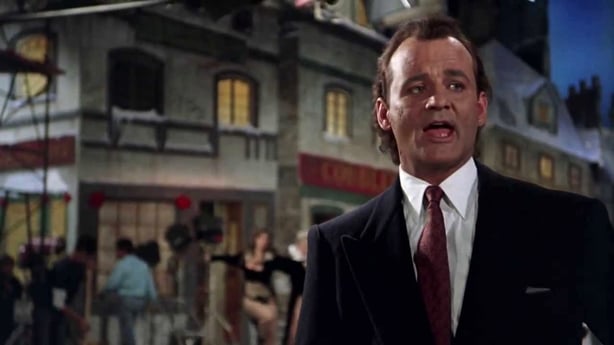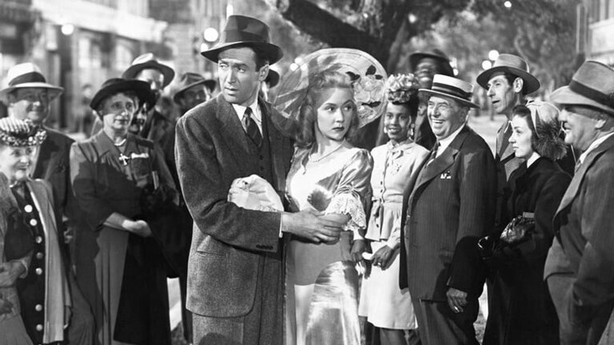Disney has an enviable back-catalogue of classic movies and TV shows. It's also spent billions of dollars on new content for its streaming service. Plenty of that has been Christmas-themed, too.
And, yet, if you catch one of the current ads for Disney+ you’ll notice that it’s a 33-year-old film – 'Home Alone’ - that takes centre stage.
This shows you the enduring power of a ‘classic’ Christmas film. Even decades on, these films can get the attention of audiences and – crucially - generate new ad or subscription revenue. These kinds of films become part of people’s festive traditions – and are practically guaranteed to be dusted off and rewatched at this time of year.
(The added irony in all of this is that Home Alone wasn’t originally a Disney film – it was released by 20th Century Fox, which Disney acquired in 2019.)
Is 'Home Alone' the biggest Christmas film ever?
We need your consent to load this rte-player contentWe use rte-player to manage extra content that can set cookies on your device and collect data about your activity. Please review their details and accept them to load the content.Manage Preferences
Technically, no.
The Christmas film that had the most success at the box office is one that most people probably wouldn’t include in their list of ‘classics’ – in part because it’s quite new.
That’s because it’s the 2018 animated version of ‘The Grinch’ that tops the festive box office records.
It made more than $540m on its release six years ago – showing the enduring appeal of Dr Seuss’s story, 61 years after the book was first published.
And the Grinch Cinematic Universe – if there is such a thing – has been a lucrative one. The live-action version of the story (starring Jim Carey) earned €347m at the box office when it was released back in 2000.
By comparison, ‘Home Alone’ has made nearly $477m at the box office. Most of which was made on its initial release in the early 90s, though there have been some re-releases over the years that made a few million too.
But it’s not really a fair comparison to make. ‘Home Alone’, of course, came out in 1991, when cinema ticket prices were lower, and a dollar was worth more.
When adjusted for inflation, Home Alone’s box office is actually more than $1 billion – so it’s far and away the biggest earner.
And the sequel did very well too – it made nearly $359m back in 1992, which is equivalent to almost $800m today.
So between those two films, you’re getting close to $2 billion at the box office.
And what makes that more remarkable is that the films are two of the many classics churned out by writer and director John Hughes at the time.
In the 80s and 90s, he was a classic film machine - writing ‘Sixteen Candles’, ‘Breakfast Club’, ‘Pretty in Pink’, ‘Ferris Bueller…’.
His contribution to the ‘Holiday’ movie genre also extends beyond ‘Home Alone’.
Three years before the attempted break-in at the MacAllisters’, he had a hit with ‘Planes, Trains and Automobiles’ (technically a Thanksgiving film – but still very festive). The year before ‘Home Alone’ he had hits with ‘Uncle Buck’ (not a Christmas film but the snowy backdrop gives it a Christmassy feel).
And he wrote ‘National Lampoon's Christmas Vacation’, which remains a cult classic to this day.
What other Christmas films did well at the box office?

The 2009 animated version of ‘A Christmas Carol’ – again, featuring Jim Carey – made $325m. That makes it the most successful version of A Christmas Carol, though there are plenty – including the Muppets’ version, the Mickey Mouse version and inventive retellings like ‘Scrooged’.
Another animated film – ‘Polar Express’ – made $315m at the box office. That’s remarkable considering the fact that the use of 3D motion capture gave the characters creepy, dead eyes.
‘Love Actually’ made a quarter of a billion at the box office – ‘Elf’, meanwhile, has made $225m.
Beyond that we start to get into the ‘Is this really a Christmas film?’ territory.
‘Gremlins’ – which is set at Christmas, but has more ‘horror’ than ‘holiday’ vibes – made $154m when it came out in 1984. That’s equivalent to $461m today.
And then of course we have ‘Die Hard’.
The first ‘Die Hard’ made $141m in 1988 – almost $370m today.
But ‘Die Hard 2’ was actually a bigger box office hit – it made $240m in 1990. That’s around $566m in today’s money.
And if you’re looking for a bit of ‘Die Hard’ trivia to fascinate your Christmas dinner guests with – the part of John McClane was actually first offered to Frank Sinatra, who was 70 at the time.
He declined – and so we ended up with Bruce Willis in the defining role of his career.
What about Christmas flops?

Well we had probably the biggest Christmas flop of all time this year, with ‘Red One’.
It’s made around $175m at the box office – which is actually pretty good… except it cost as much as $250m to make.
That was thanks to the all-star cast of Dwayne ‘The Rock’ Johnson, Chris Evans, Lucy Liu… lots of expensive special effects… and lots of on-set problems and production delays.
The rule of thumb is you need to make double your budget to break even – so it would need to hit half a billion to be in the black… and that’s not going to happen. The fact that it’s been panned by critics doesn’t help that, either.
Another, somewhat surprising flop was the 1994 remake of ‘Miracle on 34th Street’, starring Richard Attenborough and Mara Wilson.
There’s no details of the budget but it only took in $46ms at the box office – which is quite poor. By comparison Tim Allen’s ‘The Santa Clause’, which came out in the same year, took in more than $145m.
But the box office is only part of the story, isn’t it?

Yes, and this is what makes the Christmas film interesting – even more so than your standard release.
Because much like with Christmas songs - if you manage to break through as a Christmas classic, and become part of the annual tradition, then you’re guaranteed a recurring revenue stream for decades into the future.
And in the past that would have meant video and DVD sales – because people would want to have their favourite Christmas film to hand to watch at this time of year.
Around 11 million ‘Home Alone’ VHSes were sold in the US, for example.
Jim Carey’s Grinch shifted close to 21 million videos and DVDs in the US too.
That all represents hundreds of millions of dollars of extra earnings, on top of the box office takings.
Nowadays, of course, it’s about streaming – and it’s important for each of the platforms to have a good mix of Christmas films in order to draw in viewers.
Case in point is Disney’s prominent display of ‘Home Alone’ – and the fact that Netflix ensured it had both versions of The Grinch available in time for the Christmas season.
And that’s not to mention all of the TV channels that pay to be able to show Christmas classics at this time of year.
‘It’s A Wonderful Life’ is of course a standard-bearer in that – it’s 78 years old this year, but people will still sit down and watch it, or at least set their box to record it when it comes on.
The money that broadcasters, or even streamers, pay to have these films may not be enormous – it will depend on the film itself, how old it is, and whether they have exclusive rights. But if film studios can earn a little bit from each channel across multiple countries, every year, then it can add up to a very nice little income stream from an old film.
What about the other kind of Christmas film – the ones that don’t get to cinemas…

There’s almost a parallel universe of Christmas films that exist, where all of this talk of box office takings and DVD sales are completely irrelevant.
And it’s hard to find a name for them that isn’t a bit insulting – in the past they might have been called Made for TV movies, or B-Movies.
Some people call them Hallmark movies – because the Hallmark company are the leading purveyor of this sub-genre.
But it’s basically a film with an extremely low budget, and what we can charitably describe as a very basic plot.
But they are actually hugely popular… and there are tonnes of them.
How many?
Well this year alone Hallmark is releasing 32 new Christmas films.
And that kind of rate has been fairly standard for them in recent years.
It’s hard to get an exact figure, but there are somewhere between 300 and 450 Hallmark Christmas films in existence today.
And it’s become such a big part of what Hallmark does that it’s even spawned a reality TV show – called Finding Mr Christmas.
This saw ten men compete to become the male lead in one of this year’s Hallmark Christmas films.
But they’re not the only ones that make this kind of stuff – there’s another company called Great American Family, which specialises in family friendly and ‘soft’ faith-based programming.
It’s made 18 Christmas films for release this year.
And Netflix is getting in on the act too with some low-budget Christmas movies of its own.
What kinds of films are they?

They’re generally a kind of heart-warming, soft romance film. And they’re not reinventing the wheel in terms of story line.
One standard trope is that a career-driven businesswoman comes back to her home town for Christmas, finds the man of her dreams and abandons her career to be with him.
Another template sees two people who hate each other being forced to work together for some convoluted or clunky reason and – of course – they ultimately realise they have a lot in common and fall in love.
By way of an example, here are the plotlines to some of this year’s Hallmark Christmas movies.
‘Deck the Walls’ sees Rose reluctantly returns to her home town to help her brother with a charity event – and while there she meets a former love of hers.
In ‘The Christmas Charade’ a librarian is forced to pretend to be the girlfriend of an undercover FBI agent who’s trying to catch an art thief ahead of a Christmas Eve charity ball.
In ‘Tis the season to be Irish’ a woman called Rose (not the same Rose from ‘Deck the Walls’) travels to Ireland to renovate and flip a cottage, which the local realtor Seán thinks it’s a bad idea. Presumably, they fall in love by the end.
Another interesting one this year is ‘Holiday Touchdown’, which is actually a partnership with the Kansas City Chiefs - the team of Taylor Swift’s boyfriend Travis Kelce.
The team, and NFL in general, have seen an upsurge in female fans on the back of their relationship – and both Hallmark and the Chiefs have looked to capitalise on that with this film. It’s about someone trying to win their ‘fan of the year’ contest, who falls in love with their director of fan engagement. And there’s something about a missing good-luck winter hat in there, too.
But an honourable mention should go to the Netflix film ‘Hot Frosty’, about a muscular snowman who comes to life and starts dating a bereaved café owner.
How do these movies make money?
Well for a start they are made on an extremely tight budget.
They often cost less than $2m to make – which is a lot of money, but not in the film world. For comparison, HBO spent $6-8m per episode on ‘Game of Thrones’.
Part of what keeps the cost down for the likes of Hallmark is shooting in Canada, which has lots of tax breaks… and it’s a well-oiled production, with shooting being done in less than three weeks.
They also use lesser-known talent like writers and directors, as well as actors… the films often star young actors on their way up, or older actors who are on their way down in terms of their career.
But most importantly, they’re actually extremely popular.
Back in 2021, ratings agency Neilsen estimated that 80 million people in the US had watched at least a few minutes of a Hallmark Christmas film.
Because while they might not be the most innovative or ground-breaking of films, they are comfortable and easy-to-watch – and sometimes that’s what people want. They want a bit of an escape, and something that lets them turn off their brain a little.
Others, meanwhile, like to watch the films ironically – but a viewer is a viewer as far as ratings figures are concerned.
And that popularity gives Hallmark a lot of leverage in terms of the amount they can charge advertisers on the Hallmark Channel in the US – which is accessed by 70 million paying households in the US.
They of course have their own streaming service nowadays too – and then they can also sell on all of these films to channels in other countries.
That includes some dedicated movie channels – but also your standard terrestrial broadcasters, who are looking for ways to pad out the schedule at this time of year.
And they’re only too happy to pay what is first and foremost a cheap and inoffensive film, that’s also family-friendly and a bit heart-warming too.







